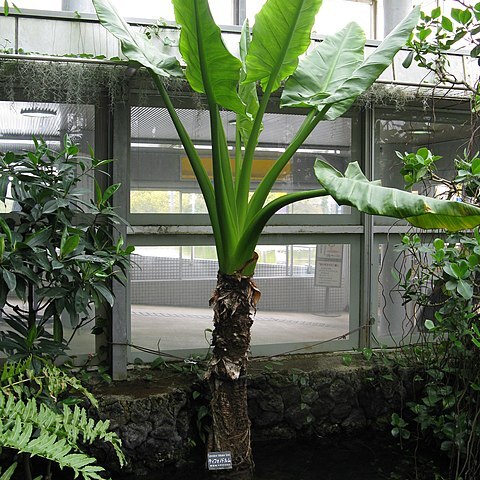Herb to 4 m. tall; pseudostem to 30 cm. thick at base or more.. Petiole, including sheath, to 3 m. long or more, upper part green, eventually deciduous with blade, lower part a very broad convolute sheath forming false stem, whitish pink, striped and spotted purplish black; blade up to 140 cm. long, 85 cm. broad, held ± erect, triangular in outline, sagittate, green, apex acute, basal lobes with acute to rounded tips, separated by triangular sinus; primary lateral veins 5–9 on each side.. Apical, exserted portion of peduncle up to 50 cm. long, 4 cm. thick, green.. Spathe up to 80 cm. long, basal tube outside yellowish green, becoming inflated and darker green after flowering, inside white to pinkish, ± 1/3 the length of the expanded, cream-yellow, acuminate limb.. Spadix up to 55 cm. long, shorter than spathe, upper staminate part and staminodial appendix together 3–4 times longer than pistillate part, yellowish to white, deciduous with spathe-limb.. Ovary reddish to yellowish.. Berries subglobose, ± 4 cm. in diameter, yellow when ripe.. Seeds ± 3 cm. long, 3 cm. broad, brownish.. Fig. 10.
More
A taro family plant with a thick trunk and broad leaves. It is a large herb that keeps growing from year to year. It has a false stem like a banana. This can be 4 m tall and 30 cm across at the base. There is an underground rhizome. The leaf stalks and sheth are 3 m long. The leaf blade is 140 cm long and 85 cm wide. It is shaped like an arrow head. The flowers are a column shaped spadix 55 cm long. It is yellow to white and has a large leaf like spathe that is 80 cm long around it. The fruit are large and oval. They contain round berries 4 cm across. These are yellow when ripe. There are 1-2 flattened brown seeds inside.
The large rootstock or rhizome is processed, roasted and eaten. They are chopped and boiled and washed several times. to remove the oxalates. Alternatively they are chopped and soaked in water for 2 days then dried in the sun. The fleshy seeds are roasted and eaten. Caution: Plants in this family usually have oxalate crystals and need special processing.

